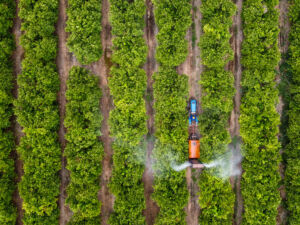The warm season in Europe marks the beginning of the high season for mosquitoes. While they and their larvae serve as prey for many animals and thus play an important role in the ecosystem, humans find the small bloodsuckers rather annoying. Meanwhile, they can also become dangerous to us: mosquitoes from tropical and Asian regions are increasingly appearing in Central Europe. They can transmit the Zika or West Nile viruses, which trigger dangerous fever diseases. A team of Hessian Scientists including ISOE-researcher Marion Mehring is showing how the further spread of these mosquito species can be prevented in a targeted and environmentally friendly way.
Of the approximately 3,500 species of mosquitoes worldwide, around 100 are native to Europe. But there are more and more: favoured by global trade and climate change, invasive species such as the Asian tiger mosquito, the Japanese bush mosquito or the yellow fever mosquito are increasingly settling here. They bring with them the ability to transmit viruses of originally tropical diseases: while the West Nile virus has already established itself in Germany, dengue and yellow fever infections are also spreading northwards from the Mediterranean region.
However, the control of invasive mosquitoes, whose larvae develop in water, is not only a great challenge technologically, but also in terms of socio-political aspects. This is because innovations in laws and regulations in the course of the German government’s “Insect Protection Action Programme” restrict the use of pesticides, especially in and around water bodies. The release of genetically modified mosquitoes is rejected by the majority of the population. But what is the best way to protect human health?
“Fire brigade” against dangerous mosquitoes
In an article published in the journal “Biotechnology Advances”, a consortium of researchers from Frankfurt and Giessen at the Centre for Translational Biodiversity Genomics TBG shows a way out of this dilemma between nature and health protection with a new technology they have developed. Their common goal is to build a kind of fire brigade against tropical diseases transmitted by mosquitoes. The research team, which also includes Marion Mehring from ISOE – Institute for Social-Ecological Research, shows how the further spread of invasive mosquito species can be prevented in a targeted and environmentally friendly manner.
Efficient monitoring of the spread of mosquitoes and viruses is initially made possible by the genetic analysis of water samples, so-called “environmental DNA”. For this purpose, the team has already sequenced the genomes of various immigrant mosquitoes to develop procedures that enable reliable detection similar to a PCR test. In a second step, the new technology of “RNA interference” is used, in which the mosquito larvae in the distribution area are provided with food that contains double-stranded ribonucleic acids – RNAs for short.
Environmentally friendly technology against pathogens
These important information and function carriers, which are found in every cell of living organisms, then unfold their effect via the larvae’s intestine and switch off some of their genes that are important for survival. The advantages of this method are that the RNA molecules can be produced in such a way that they only act against the respective mosquito species and do not endanger other insect species or humans. Furthermore, no toxic residues are left in the environment during their degradation. This method does not produce genetically modified mosquitoes capable of reproducing.
The publication makes recommendations on how RNA interference, or RNAi for short, can be developed to market maturity in Europe as an innovative and environmentally friendly technology for the control of so-called vectors – pathogen-transmitting organisms. Sprays based on RNAi are also being developed against insect pests such as the Colorado potato beetle and are soon to be marketed as an environmentally friendly alternative to conventional pesticides.
From market maturity to societal acceptance
However, the help of citizens is needed in order to successfully apply the new technology. ISOE-biodiversity researcher Marion Mehring therefore recommends including questions of societal acceptance in the development and implementation of the new technology: How can the risk perception and problem awareness for the control of dangerous mosquitoes be increased in the local population? How can citizens be encouraged to use the new technology themselves? The owners of gardens, for example, are in demand for the consistent control of mosquitoes – the occurrence of dangerous mosquitoes is particularly high there.
Members of the consortium lead by Andreas Vilcinskas, head of the Bioresources section at the Fraunhofer Institute for Molecular Biology and Applied Ecology IME in Giessen are currently researching the development of double-stranded RNAs that are particularly well suited for mosquito control and virus control. The consortium includes partner institutions such as Goethe University Frankfurt am Main, Justus Liebig University Gießen, the Senckenberg Society for Nature Research, the ISOE – Institute for Social-Ecological Research (ISOE) in Frankfurt and the Institute of Tropical Medicine in Antwerp, Belgium.
Publication in Biotechnology Advances
Ruth Müller, Miklós Bálint, Kornelia Hardes, Henner Hollert, Sven Klimpel, Eileen Knorr, Judith Kochmann, Kwang-Zin Lee, Marion Mehring, Steffen U. Pauls, Greet Smets, Antje Steinbrink, Andreas Vilcinskas
“RNA interference to combat the Asian tiger mosquito in Europe: A pathway from design of an innovative vector control tool to its application”
https://doi.org/10.1016/j.biotechadv.2023.108167
Scientific contact:
Dr. Marion Mehring
Tel. +49 69 707 6919-39
mehring@isoe.de
www.isoe.de
Press contact:
Melanie Neugart
Tel. +49 69 707 6919-51
neugart@@isoe.de
www.isoe.de
Contact:


